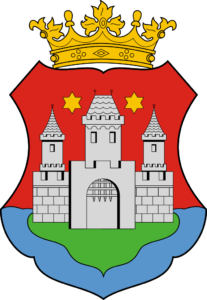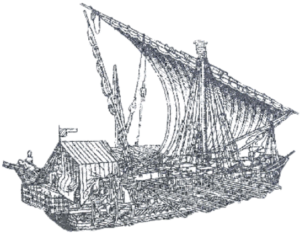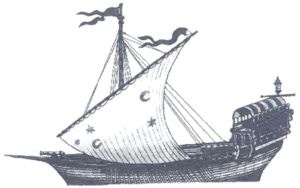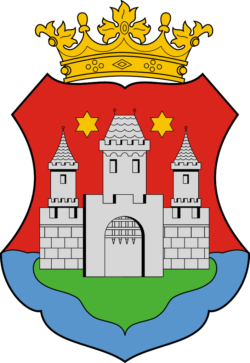Komárom

Komárom Castle
Komárom and Komárno are basically one city. They are at the confluence of the Danube and the Vág rivers, and one of the cities is located in the Upper lands (Horná Zem, Felvidék) in Slovakia, and is called Komarno. The other part is still in Hungary and it is known as Komárom. They were divided this way in 1918. In the age of Ottoman wars, whoever owned Komárom, could control three large regions of Hungary, namely the Dunántúl (Trans-Danubian Region) the Csallóköz, and the Mátyusföld.

Komárom Castle was a formidable fortress, blocking the Danube before Vienna and Pozsony (Bratislava, Pressburg), making all river passage impossible and it was a very good crossing place. The city has a system of forts, bastions, and fortifications on both banks of the river Danube. Now, there is the “New Castle” and the “Old Castle”.

The history of Komárom dates back to the time of the Hungarian Chief Árpád’s Home Taking in the 9th century when he gave this area to his man, Ketel. After Ketel’s son Alaptolma built the first earthen castle, Komárom was established from the three villages of Komáromfalva, Andrásfalva, and Keszifalva.

The settlement became the center of Komárom County, one of the earliest counties of the Kingdom. The Mongols could not destroy it in 1241 because of the rivers which protected the castle well enough. King Béla IV gifted the town with privilege and turned it into a royal town, a “regis civitatis” in 1265 because of the city’s great market, busy harbor, and ferry. It was the time when the stone castle was built.

Later it fell into the hands of Csák Máté, the mighty oligarch. Lord Máté gave further privileges to the town in 1307 which were confirmed later by King Zsigmond. King Albert of Hungary died near Komárom, at Neszmély in 1439 and his widow took refuge in the castle of Komárom. Read more about him here:
Queen Elisabeth, widow of King Albert gave birth to King László V there in 1440 and she made her plots with Baron Cillei to steal the Holy Crown of Hungary from Visegrád. Queen Elisabeth stayed in Komárom until the summer of 1440. Later, King László V awarded his birthplace with four letters of privileges. The role of the city was growing in the period of the Hunyadi family. King Matthias Corvinus visited there first in 1465 when he led his campaign against the Czech lands. The king and his wife, Queen Beatrix liked to stay in their palace in Komárom. They had a game reserve park and a royal pleasure boat there.

King Ulászló II fled to Komárom from cholera in 1520 hoping that the rivers would keep the epidemic out from there. After the Battle of Mohács, the role of Komárom became more significant than ever before because the castle’s cannons were able to block the Ottoman fleet on the Danube. The first siege took place in 1527 when King Ferdinand’s army took it after a day-long-bombardment. Two years later, his garrison surrendered the castle to Sultan Suleiman but the Turks did not leave guards in it so it was retaken without a fight. Regarding Komárom’s central location, the attacks of the Ottomans had been continuous until 1683.
There was a river battle at Komárom during the Dual Kingship in 1532 when Sultan Suleiman was on his way to take Vienna but his army was delayed by the heroic defenders of Kőszeg Castle. In the meantime, King Szapolyai’s sloops were successful against the German ships. Szapolyai had 68 vessels and attacked King Ferdinand’s fleet of 49 sloops. The Hungarians sank 36 German ships but Szapolyai had no troops to take Komárom Castle with.

After the fall of Buda in 1542, King Ferdinand realized the importance of Komárom and had it fortified. The Italian Pietro Terbosco designed the first modern fort in 1550. Next year, the Turks tried to take the fort with a surprise attack at dawn but they were repelled. Soon, the Ottomans took themselves into Esztergom, which was very close to Komárom. It was a great threat because the Ottoman warriors of Esztergom were renowned for their raids against the Mining Towns and at the same time, they were controlling the water of the Danube with their well-supplied fleet.

In 1583, the sloopers of Komárom had their black day because they ran into the snare of the Turks. The Turks considered this victory a major one. Habsburg Rudolf sent a message to the Pasha of Buda that this time, it was the Turks who had broken the Truce and thus demanded the release of all the captured soldiers which was not granted.

The famous Count Pálffy Miklós (1552-1600) was appointed as the Captain of Komárom in 1584. His first deed was to lead his warriors to Esztergom Castle where they challenged the Turks for duels. A famous Ottoman warrior, Deli Halil, was said to have been slain there. The raids and counter-raids frequently followed each other and the Turks were often seen at the walls of Komárom.
It is worth noting that during the first three years of the leadership of Captain Pálffy, the Turks had attacked the city thirty times. Not all of his raids were successful, though. Pálffy was beaten and lost 278 men during his ill-fortuned raid in 1587. Pálffy’s Vice Captain, Thury Márton reported to the king in 1586 that the enemy was building a boat bridge across the Danube between Esztergom and the Palisade Castle of Párkány. In answer to this, Archduke Ernő Habsburg ordered Captain Pálffy to build a bridge, too.

Pálffy, who had had two small palisades made on the bank of the Danube and of the Vág in 1585 was given all the supplies to have the boat bridge built. A certain bridge master called Jurisich Lajos from Pozsony was in charge of the construction and in 1589 he was ready with the 500-step-long boat bridge over the Danube. Eighty boats and two big “old boats” or sloops were used for the building. Just to make sure, Pálffy Miklós had another small palisade fort erected to guard the bridge. As Komárom was the most important castle in the chain of forts of the Hungarian Borderland, further forts were built after 1592.
The siege of Komárom in 1594
The Szent Miklós (Saint Nicholas) Palisade (later became the Star-Fort) was built on the right bank of the Danube while the Szent Fülöp (Saint Philip) Palisade was erected on the left. Hardly had the Italian engineers finished the new fort system in the summer of 1594 when it was put to the test in the autumn. Grand Vizier Sinan victoriously took the castles of Tata and Győr, then attacked Komárom with a huge army of 50,000 men. Sinan wanted to capture the last remaining strong fort of the area in preparation for taking Vienna in the following year. At first, he sent his son, Szinánpasazáde Mehmed to Komárom, then followed him in person.

As Count Pálffy was fighting against the Pasha’s huge army near Győr, the defenders were led by Captain Erasmus Praun and by Captain of the sloopers, Sztarcsics Farkas. They had only 1,000 men before the siege commenced but the Austrians had taken many of the sloopers to strengthen the Christian army at Győr. We do not know whether they could get back to Komárom before 4 October or not. In Komárom, the defenders had only 300 German infantrymen, a couple of hundred Hungarian Hussars, and 600 sloopers left. On top of this, many sloopers chose to flee the castle before the siege, though.

Captain Praun was sending lots of letters to the Military Council, demanding more men. We know that the Council sent Hans Jäger Hauptmann with 200 soldiers on 30 September to Komárom but they were not in a hurry to arrive: all we know is that they were not in Komárom on 8 October. Braun asked for miners, too because they were supposed to prevent the enemy’s mines. Unfortunately, the miners he got did not do a good job. Also, there was not enough food and gunpowder.

Praun did not have enough artillery because he had had to send cannons to Győr castle beforehand. There were cannons in the poorly defended market town of Komárom but they could not tow them into the castle, so they had to sink some of them into the river. Later, they lost three of their best cannons during the siege.


All in all, the Austrians were able to reinforce the castle with approximately 1,200 troops just before the siege began on 4 October 1594. The cannonade began on 7 October. However, the Turks’ cannonballs could not cause much harm from the other side of the river because the Danube was very wide. It was the reason why Sinan sent Crimean Tatar riders to the Csallóköz area to surround the city. The next day, they managed to build a bridge, and soon the Turks could deploy 18 cannons near the walls, next to the burned church of the town. Then, they shot the fort of Komárom from the trenches next to the moat.
Fortunately, Count Pálffy Miklós, the Chief Captain of Érsekújvár albeit injured himself was bringing the reinforcement to his beloved Komárom Castle’s relief on 15 October, at night. He could get 1,800 soldiers into the fort. Thus, the defenders’ number grew to about 3,000 men.

The Ottomans herded Hungarian peasants to dig trenches to reach the walls. As the bombardment was not effective, Pasha Sinan tried to explode some mines under the walls because the counter-mines of the defenders were insufficient. As the garrison’s miners could not do a good job, 300 soldiers of the defenders ambushed the Janissaries and slaughtered them on 22 October. They cut down the Hungarian peasants as well who had been forced to labor for the enemy. The unit was led by Stracsics Farkas, and inflicted great harm on the enemy, bringing in lots of supplies and even a few cannons. They managed to destroy the enemy’s tunnel, too. The lieutenants of the sloopers, Contrarius Márton and Zapata Ferenc even destroyed several Turkish sloops.

It was when Captain Praun was shot in his right knee by a Jannissary, between 19 and 22 October. He said he was crying from pain day and night. Despite his injury, the Captain had himself taken on the next day among his soldiers and encouraged them to sally out. After the sally, the enemy resumed the cannonade on 24 October, this time the cannons were deployed near the brick-maker trench.
However, a few days later, the morale of the epidemic and cold-struck Turks became so low that Pasha Sinan quit the one-month-long siege, losing more than 800 of his men so far in vain. For the Ottomans, the day of Kászim (26 October) was the traditional end of the fighting season, and the soldiers were reluctant to fight on.

Sinan did not know how little gunpowder and supplies were left within the walls. This Ottoman campaign had been a lengthy one, and they suffered serious losses during the sieges of Tata, Szentmárton (Pannonhalma), and especially at Győr castles. The resistance of Komárom’s defenders was also disheartening to the Ottoman soldiers, and they received news about the coming of the Christian reinforcing army. In fact, Archduke Matthias managed to assemble a large Imperial army and they were on the march. When they got there, they could not find the Turks there because they were three days late.
As it was, Sinan`s troops began to retreat on 25 October and then they set the boat bridge behind them on fire. He called the Tatars back from the Csallóköz, too. Seeing this, the defenders of Komárom took on their sloops, and first, they sent a volley of cannon fire after the hastily retreating enemy, then began to chase them. They nailed the enemy’s cannons or broke their wheels when they got there. At that point, panic broke out in the Ottoman army, and they began to flee toward Tata castle. They dragged the Grand Vizier with them who could hardly sit in the saddle.


After the great siege
The plight of the surviving population was worsened by the incoming German and Czech mercenaries who were furious because they had not been paid and pillaged the land as savagely as the Tatars had done so.

Zsitvatő village is located next to Komárom and it was the place where the Peace Treaty of Zsitvatorok was made in 1606 between King Rudolf and the Ottoman Sultan as a conclusion of the 15-Year-War. Komárom city had a Reformed College this year and the Catholics had their high school established thirty-three years later. The next negotiations between the Christians and the Muslims took place on the island of Komárom in 1627 and they resulted in the Peace Treaty of Szőny.

Due to the new Ottoman peril, the castle was improved further in 1663 and 1673 by Italian and French engineers. Both the city and the forts were seriously damaged in the flood of 1682. After the Siege of Vienna in 1683, the withdrawing Ottoman troops were utterly beaten in the two-day-long Battle of Párkány, not far from Komárom.

On the first day, the 5,000 Polish cavalries under King Sobieski were defeated by the 50,000-strong Ottoman army led by Kara Mehmed Pasha. More than 1,000 Polish Hussars and dragoons were slain. The 28,000-strong Austrian forces of Charles V, Duke of Lorraine arrived on the next day and together they attacked the Turks who tried to withdraw their army via the boat bridge between Esztergom and Párkány.

The Austrians had the bridge bombarded to shreds, besieging and taking the Palisade of Párkány. The battle was not only a whole-scale battle on the field but it raged on the water and included a siege as well. Finally, the men of the Duke and the Polish King Sobieski won a decisive victory over the Ottomans, killing 9,000 of them. Unfortunately, the troops of Prince Thököly Imre were on the Turks’ side in this battle. After the defeat, the Austrians besieged Esztergom and Pasha Ibrahim ceded it to them. Soon, the Ottomans were driven out of the country and Komárom’s role diminished, although the city became the fifth-biggest town in the country by 1715.

There were five major earthquakes during the 18th century which ruined the buildings. Yet, the Habsburgs decided to rebuild the forts and huge reinforcements were taking shape between 1827-39. Later, Komárom had a heroic role in the Hungarian War of Independence from 1848 to 1849. Now, its huge brick walls give a home to festivals every summer, to our greatest joy.

Most Hungarian people know of Komárom because of Klapka György who was able to defend it against the Habsburgs with success in the War of Independence in 1849.
Sources: Szibler Gábor and Bagi Zoltán: Komárom, 1594. In.: Levéltári Szemle. 2015. 3. szám
I wrote a dramatized historical short story about the sloopers’ fight on the Danube near Komárom, it can be read in my book “33 Castles, Battles, Legends”:
Dear Readers, I can only make this content available through small donations or by selling my books or T-shirts:
Please, feel free to support me with a coffee here:
You can check out my books on Amazon or Draft2Digital, they are available in hardcover, paperback, or ebook:
https://www.amazon.com/dp/198020490X or at https://books2read.com/b/boYd81

My work can also be followed and supported on Patreon: Become a Patron!http://Become a Patron!































































